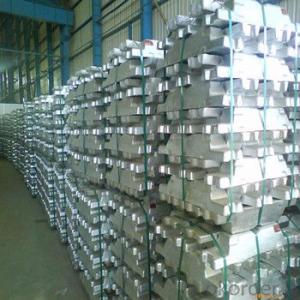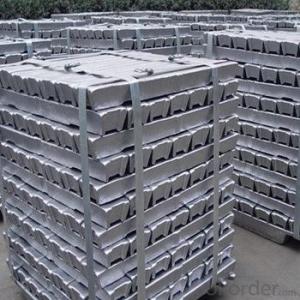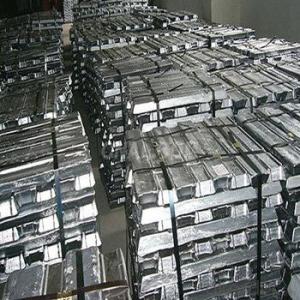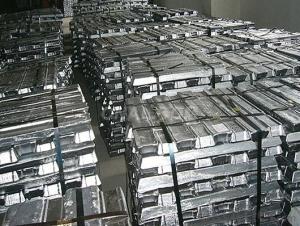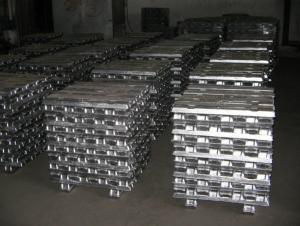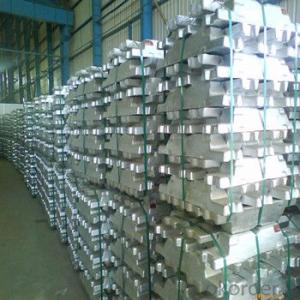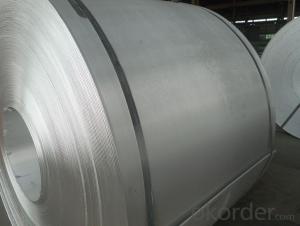Aluminum Pig/Ingot With High Purity And Low Price
- Loading Port:
- China main port
- Payment Terms:
- TT OR LC
- Min Order Qty:
- 5000 m.t.
- Supply Capability:
- 100000 m.t./month
OKorder Service Pledge
OKorder Financial Service
You Might Also Like
Pure Aluminum Pig/Ingot Used for Industry
1.Structure of Aluminum Pig/Ingot
A material that has been cast into a shape in order to be transported and processed easier than in an unprocessed form. An ingot is typically rectangular in shape, which allows it to be stacked. Ingots are most commonly associated with metals, with ingots of gold held in the vaults of banks and brokerages being popular images.
Aluminum Ingot is with the AL as the main chemical composition.Aluminum Ingot is used for industry,such as automobile,pinning and weaving,electron broadly and so on. Aluminum Ingot has the following advantages: easy control and operation, fast melting.
2.Main Features of the Aluminum Pig/Ingot
•High Purity
•Easy control and operation
•High strength
•Fast melting
•Competitive price
•Best Service
3.Aluminum Pig/Ingot Images


4.Aluminum Pig/Ingot Specification
Grade | Chemical Composition % | |||||||||
Al≥ | impurities ≤ | |||||||||
Si | Fe | Cu | Ga | Mg | Zn | Mn | others | Sum | ||
Al99.9 | 99.90 | 0.50 | 0.07 | 0.005 | 0.02 | 0.01 | 0.025 | - | 0.010 | 0.10 |
Al99.85 | 99.85 | 0.80 | 0.12 | 0.005 | 0.03 | 0.02 | 0.030 | - | 0.015 | 0.15 |
Al99.7 | 99.70 | 0.10 | 0.20 | 0.010 | 0.03 | 0.02 | 0.030 | - | 0.030 | 0.30 |
Al99.6 | 99.60 | 0.16 | 0.25 | 0.010 | 0.03 | 0.03 | 0.030 | - | 0.030 | 0.40 |
Al99.5 | 99.50 | 0.22 | 0.30 | 0.020 | 0.03 | 0.05 | 0.050 | - | 0.030 | 0.50 |
Al99.00 | 99.00 | 0.42 | 0.50 | 0.020 | 0.03 | 0.05 | 0.050 | - | 0.050 | 1.00 |
5.FAQ of Aluminum Pig/Ingot
We have organized several common questions for our clients,may help you sincerely:
①How about your company?
A big and famous and professional manufacturer & supplier of Aluminum Pig/Ingot, is one of the one of the large-scale professional investment Aluminum Pig/Ingot production bases in China.It have focuses on producing the Aluminum Pig/Ingot production for many years and gotten rich experience.Annually lagrge amount of Aluminum Pig/Ingot production are exported to markets in Europe,America and Japan. The quality and service have also gotten OEM service is available according to customer’s requirements.
②How to guarantee the quality of the products?
We have established the international advanced quality management system,every link from raw material to final product we have strict quality test;We resolutely put an end to unqualified products flowing into the market. At the same time, we will provide necessary follow-up service assurance.
③How long can we receive the product after purchase?
In the purchase of product within three working days, We will arrange the factory delivery as soon as possible. The pecific time of receiving is related to the state and position of customers.Commonly 7 to 10 working days can be served.
- Q:What are the different extrusion processes for aluminum ingots?
- There are several different extrusion processes for aluminum ingots, including direct extrusion, indirect extrusion, and hydrostatic extrusion. In direct extrusion, the aluminum ingot is forced through a die using a ram. Indirect extrusion involves placing the ingot in a hollow container and applying pressure to force it through a die. Hydrostatic extrusion uses a fluid to apply pressure to the ingot, pushing it through a die. Each of these processes has its own advantages and is used depending on the specific requirements of the product being manufactured.
- Q:What are the different forging techniques for aluminum ingots?
- Some of the different forging techniques for aluminum ingots include open-die forging, closed-die forging, and ring rolling. In open-die forging, the aluminum ingot is placed between two flat dies and compressed to shape it. Closed-die forging involves using shaped dies to create intricate and precise shapes. Ring rolling is a specialized technique where the ingot is rolled into a ring shape using radial and axial forces. These techniques allow for the production of a wide range of aluminum products with varying shapes and sizes.
- Q:Where to recycle aluminium ingot?
- I broke a can. Ah, 1~2 tons of aluminum a month, can't you?
- Q:What is the difference between remelting aluminium ingot and alloy aluminium ingot?
- The general is scrap aluminum remelting aluminum ingot, all kinds of discarded products by melting furnace melting, remelting aluminum components, is likely to exceed the standard, some elements of impurities, authentic alloy ingot is made of pure aluminum made with various metal elements according to the ratio of melting, various elements with fewer impurities than accurate, high quality products. Out of the production.
- Q:What is the average price of an aluminum ingot?
- The price of an aluminum ingot can fluctuate based on several factors, including market conditions, supply and demand dynamics, and regional influences. As of [current date], the average price stands at around [average price]. Nevertheless, it is crucial to acknowledge that this value is prone to alterations. It is advisable to seek guidance from industry sources or market experts for the latest and most accurate pricing information.
- Q:How is aluminum ingot different from aluminum billet?
- Aluminum ingot and aluminum billet are both forms of raw aluminum, but they differ in terms of shape and size. Aluminum ingot is typically rectangular or trapezoidal in shape and is larger in size compared to aluminum billet. Ingots are usually cast in a mold and are used as the initial material for various aluminum products. On the other hand, aluminum billet is cylindrical or round in shape and is smaller in size. Billets are typically created by extruding or casting and serve as the starting point for further processing, such as machining or rolling, to create specific aluminum products.
- Q:How are aluminum ingots used in the production of doors and windows?
- Due to their inherent properties and versatility, aluminum ingots play a crucial role in the production of doors and windows. The first step involves melting down these ingots to create molten aluminum, which is then used to manufacture various door and window components. One primary application of aluminum ingots lies in the extrusion process. This process entails forcing the molten aluminum through a specially designed die to create continuous profiles of different shapes and sizes. These profiles serve as the foundation for door and window frames, sashes, mullions, and other structural elements. The extrusion process allows for tremendous design flexibility, enabling manufacturers to produce intricate and lightweight profiles that meet specific requirements. Furthermore, aluminum ingots are also employed in fabricating hardware components, including handles, locks, hinges, and fasteners. These parts are essential for the proper functioning and security of doors and windows. Aluminum's lightweight yet durable nature makes it the preferred choice for such hardware, as it offers strength without adding unnecessary weight to the final product. Additionally, aluminum ingots find use in the production of door and window panels. These panels can be crafted from aluminum sheets, which are formed, cut, and assembled to achieve the desired design. Aluminum panels deliver excellent thermal and sound insulation properties, making them energy-efficient and capable of reducing external noise. The utilization of aluminum ingots in the production of doors and windows offers several advantages. Firstly, aluminum exhibits high resistance to corrosion, ensuring that the finished products maintain their appearance and functionality over time. Secondly, aluminum is a lightweight material, making the doors and windows easier to handle and install. Lastly, aluminum is a sustainable and recyclable material, aligning with the growing demand for environmentally friendly products. In conclusion, the extensive use of aluminum ingots in the production of doors and windows stems from its unique properties. From forming extruded profiles to manufacturing hardware components and panels, aluminum serves as an ideal material for creating durable, lightweight, and aesthetically pleasing products.
- Q:Can aluminum ingots be used in the production of musical instruments?
- Yes, aluminum ingots can be used in the production of musical instruments. Aluminum is a lightweight and durable metal that can be molded into various shapes, making it suitable for the construction of instrument bodies, parts, and accessories.
- Q:What are the different forms of aluminum ingots available in the market?
- There are several different forms of aluminum ingots available in the market, each designed to meet specific industrial and commercial needs. The most commonly found types include: 1. Primary Aluminum Ingots: These are produced through the electrolytic reduction of alumina, resulting in high-purity aluminum ingots. They are typically used in various manufacturing processes, including automotive, aerospace, and construction industries. 2. Secondary Aluminum Ingots: These ingots are made from recycled aluminum scrap, which is melted and refined before being cast into ingots. Secondary aluminum ingots are more cost-effective and environmentally friendly compared to primary ingots, making them popular in industries such as packaging, electronics, and consumer goods. 3. Alloyed Aluminum Ingots: These ingots are made by adding specific alloying elements, such as copper, silicon, or magnesium, to the aluminum during the smelting or casting process. Alloyed aluminum ingots offer enhanced mechanical properties, corrosion resistance, and other desired characteristics, allowing their use in various applications like automotive parts, aircraft components, and building materials. 4. High-Purity Aluminum Ingots: These ingots are manufactured with an exceptionally high level of purity, often exceeding 99.99%. They are primarily used in industries that require ultra-clean and low-contamination materials, such as electronics, semiconductors, and solar panels. 5. Cast Aluminum Ingots: These ingots are produced through the casting process, where molten aluminum is poured into molds and allowed to solidify. Cast aluminum ingots are versatile and can be further processed into various shapes and sizes, making them suitable for different industries, including automotive, construction, and marine. It is important to note that the availability of these different forms of aluminum ingots may vary depending on the specific market and region. Additionally, each type of ingot has its own set of advantages, disadvantages, and applications, so it is crucial to choose the appropriate form based on the intended use and requirements.
- Q:What is aluminium ingot? Is it different from other series of aluminum?
- The problem lies in the production process, the mold work with a problem, to the mold work belt repair, this you have to let manufacturers solve.
1. Manufacturer Overview |
|
|---|---|
| Location | |
| Year Established | |
| Annual Output Value | |
| Main Markets | |
| Company Certifications | |
2. Manufacturer Certificates |
|
|---|---|
| a) Certification Name | |
| Range | |
| Reference | |
| Validity Period | |
3. Manufacturer Capability |
|
|---|---|
| a)Trade Capacity | |
| Nearest Port | |
| Export Percentage | |
| No.of Employees in Trade Department | |
| Language Spoken: | |
| b)Factory Information | |
| Factory Size: | |
| No. of Production Lines | |
| Contract Manufacturing | |
| Product Price Range | |
Send your message to us
Aluminum Pig/Ingot With High Purity And Low Price
- Loading Port:
- China main port
- Payment Terms:
- TT OR LC
- Min Order Qty:
- 5000 m.t.
- Supply Capability:
- 100000 m.t./month
OKorder Service Pledge
OKorder Financial Service
Similar products
New products
Hot products
Related keywords


